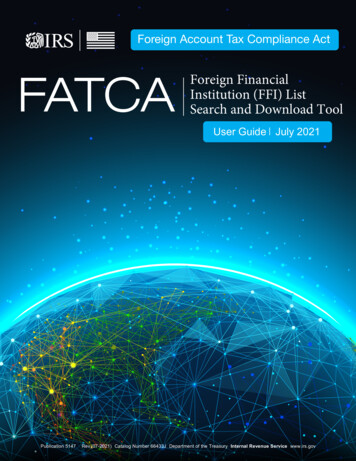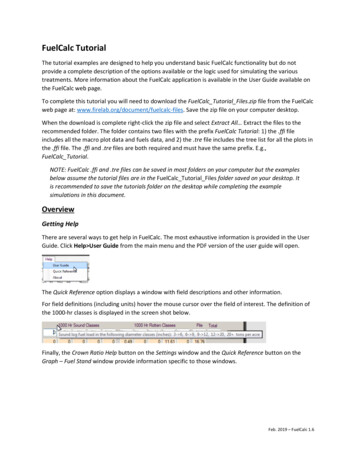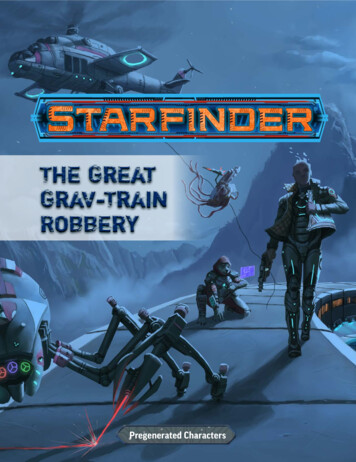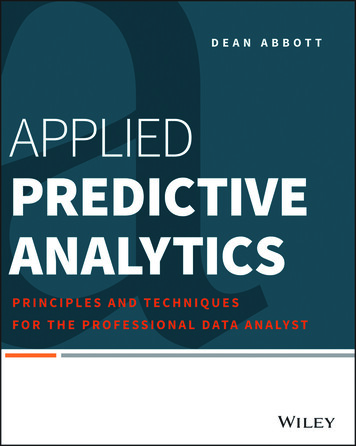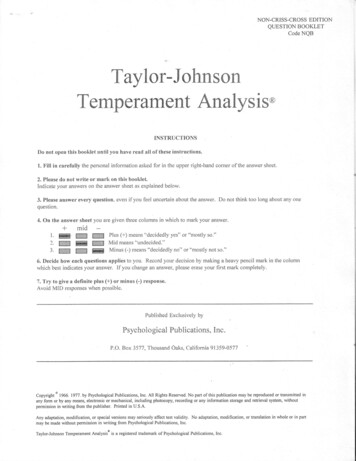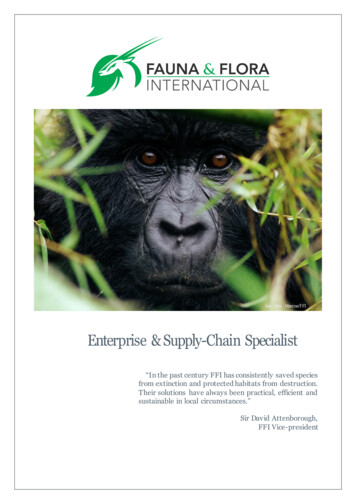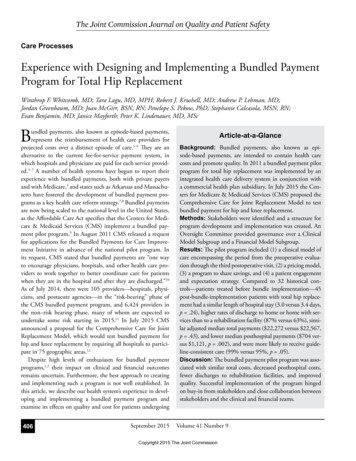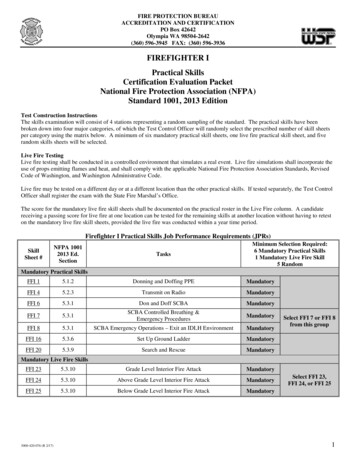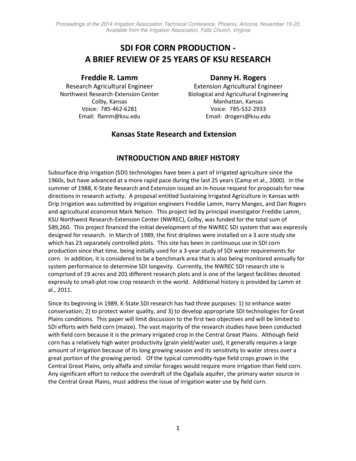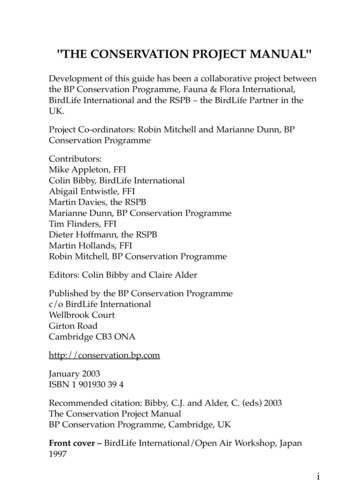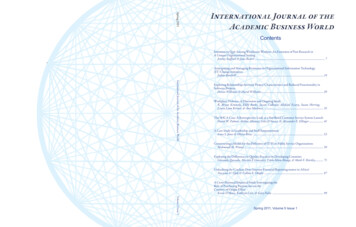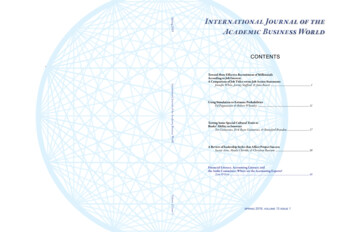
Transcription
Spring 2019International Journal of theAcademic Business WorldCONTENTSInternational Journal of the Academic Business WorldToward More Effective Recruitment of MillennialsAccording to Job Interest:A Comparison of Job Titles versus Job Action StatementsJennifer White, Jeremy Stafford, & Jana Beaver .1Using Simulation to Estimate ProbabilitiesEd Pappanastos & Robert Wheatley .11Testing Some Special Cultural Traits toBanks’ Ability to InnovateTor Guimaraes, Erik Ryan Guimaraes, & Bransford Brandon.17A Review of leadership Styles that Affect Project SuccessSusita Asree, Moula Cherikh, & Christian Baucum .36Financial Literacy, Accounting Literacy, andthe Audit Committee: Where are the Accounting Experts?Tom Wilson .48Volume 13 Issue 1Spring 2019, Volume 13 Issue 1
INTERNATIONAL JOURNAL OF THEACADEMIC BUSINESS WORLDJW PRESSMARTIN, TENNESSEE
Copyright 2019 JW PressAll rights reserved. No part of this publication may be reproduced, stored in a retrieval system or transmitted in any form or by any means electronic, mechanical,photocopying, recording or otherwise, without the prior written permission of the publisher.Published byJW PressP.O. Box 49Martin, Tennessee 38237Printed in the United States of America
EditorDr. Edd R. JoynerEddJoyner@AWoIC.orgBoard of li AhmadiMorehead State UniversityKYUnited StatesIsmet AnitsalTennessee Technological UniversityTNUnited StatesW. Kevin BarksdaleGrand Canyon UniversityTNUnited StatesDustin BessetteThe National Graduate SchoolMAUnited StatesThomas A. BuchmanUniversity of Colorado at BoulderCOUnited StatesJodine M. BurchellWalden UniversityOnlineUnited StatesDarrell Norman BurrellThe National Graduate SchoolMAUnited StatesSharon L. BurtonThe National Graduate SchoolDEUnited StatesCatherine CareyWestern Kentucky UniversityKYUnited StatesMacgorine CassellFairmont State UniversityWVUnited StatesJason G. CaudillKing UniversityTNUnited StatesSJ (Steve) ClaydenUniversity of PhoenixAZUnited StatesMichelle ClémentCamosun CollegeBCCanadaHoward CochranBelmont UniversityTNUnited StatesAshley Courtney-DattolaCapella UniversityMohamed El-KaissyUniversity of PhoenixAZUnited StatesNoory EtezadyNova Southeastern UniversityOstan-e TehranIranEveline M. FallshawRMIT UniversityCarolyn J. FausnaughFlorida Institute of TechnologyFLUnited StatesGreg FlanaganUniversity of LethbridgeAlbertaCanadaGreg FleetUniversity of New Brunswick in Saint JohnNew BrunswickCanadaDenise GatesGates To Success Consulting GroupCOUnited StatesNancy GautierUniversity of MobileALUnited StatesDaniel GifondorwaEastern New Mexico UniversityNMUnited StatesMarilyn L. GradyUniversity of Nebraska-LincolnNEUnited StatesBrian C GrizzellWalden UniversityOnlineUnited StatesRajendra GuptaMemorial University of NewfoundlandNewfoundlandCanadaMichael HadaniLong Island University - C.W. Post CampusNYUnited StatesGeorgia HaleUniversity of Arkansas at Fort SmithKSUnited StatesMary Lewis HaleyCumberland UniversityTNUnited StatesBetty S. HarperMiddle Tennessee State UniversityTNUnited StatesBrenda HarperAmerican Public UniversityWVUnited StatesGy R. HashimUniversiti Teknologi MARASelangorMalaysiaLevon HayrapetyanHouston Baptist UniversityTXUnited StatesBrook HendersonColorado Technical UniversityCOUnited StatesHarry E. HicksButler UniversityINUnited StatesIwu HilaryMorehead State UniversityKYUnited StatesUnited StatesAustralia
Ellen HoadleyLoyola College in MarylandMDUnited StatesHilary O. IwuMorehead State UniversityKYUnited StatesKalinga JagodaMount Royal CollegeAlbertaCanadaBenton Cooper JohnsonUniversity of Tennessee at MartinTNUnited StatesHalil KayaEastern Kentucky UniversityKYUnited StatesAnnette KlugeUniversity of St. GallenSt. GallenSwitzerlandLeon KorteUniversity of South DakotaSDUnited StatesMelinda L. KorzaanMiddle Tennessee State UniversityTNUnited StatesJohn KuforijiTuskegee UniversityALUnited StatesEhsan LatifUniversity College of the CaribooBritish ColumbiaCanadaThomas A. LechnerTennessee State UniversityTNUnited StatesChristopher R. LeupoldElon UniversityNCUnited StatesChi Lo LimNorthwest Missouri State UniversityMOUnited StatesJamye LongUniversity of Tennessee at MartinTNUnited StatesGreg LowhornPensacola Christian CollegeFLUnited StatesNicholas Blessing MavengereUniversity of TampereRose McNeeseUniversity of Southern MississippiMSUnited StatesCarmen I. Figueroa MedinaUniversity of Puerto Rico, MayaguezPRPuerto RicoDan MeyerAustin Peay State UniversityTNUnited StatesKelly MollicaThe University of MemphisTNUnited StatesBrian MotiiUniversity of MontevalloALUnited StatesPeter MungerUniversity of Maryland University CollegeMDUnited StatesAnthony NegbeneborGardner-Webb UniversityNCUnited StatesStephanie NewportAustin Peay State UniversityTNUnited StatesSusanne Bruno NinassiMarymount UniversityVAUnited StatesShirley NoseworthyMemorial University of NewfoundlandNewfoundlandCanadaCollins E. OkaforNorth Carolina A&T State UniversityTXUnited StatesRobert D. O'KeefeDePaul UniversityILUnited StatesW. Timothy O'KeefeUniversity of West FloridaFLUnited StatesChristie Onwujuba-DikeUniversity of Saint FrancisINUnited StatesLeticia E. PeñaUniversity of Wisconsin-La CrosseWIUnited StatesAnthony PittareseEast Tennessee State UniversityTNUnited StatesFinland
Paula PotterWestern Kentucky UniversityKYUnited StatesRichard PowersEastern Kentucky UniversityKYUnited StatesLeonard PresbyWilliam Paterson UniversityNJUnited StatesArnold RedmanUniversity of Tennessee at MartinTNUnited StatesElizabeth E. RegimbalCardinal Stritch UniversityWIUnited StatesCarolyn ReichertThe University of Texas at DallasTXUnited StatesHong RimShippensburg UniversityPAUnited StatesEbrahim RoumiUniversity of New BrunswickNew BrunswickCanadaDonna M. SchaefferMarymount UniversityVAUnited StatesBarbara SchuldtSoutheastern Louisiana UniversityLAUnited StatesDerek SedlackNova Southeastern UniversityFLUnited StatesPatricia SelvyBellarmine UniversityKYUnited StatesGeorgi SmatrakalevFlorida Atlantic UniversityFLUnited StatesKathleen L. SobieralskiUniversity of Maryland University CollegeMDUnited StatesAmir H. Soheili-MehrUniversity of TorontoOntarioCanadaHarriette SpiegelUniversity of Tennessee at MartinTNUnited StatesUma V. SridharanColumbus State UniversitySCUnited StatesPaul C. StumbCumberland UniversityTNUnited StatesBeverly Ann SwisshelmCumberland UniversityTNUnited StatesRobert TerrellCarson-Newman UniversityTNUnited StatesJeffrey TottenMcNeese State UniversityLAUnited StatesDaniel L. TracyUniversity of South DakotaSDUnited StatesSheila Marie TrzcinkaIndiana University NorthwestINUnited StatesJulie UrdaRhode Island CollegeRIUnited StatesMarie Louise van der KloosterDeakin UniversityVictoriaAustraliaAnthony VarnonSoutheast Missouri State UniversityMOUnited StatesCharles VehornRadford UniversityVAUnited StatesRoger Alan VossInstitute of Production ControlTXUnited StatesKathryn H. WoodsAustin Peay State UniversityTNUnited StatesMichael J. WrightTarleton State UniversityTXUnited StatesTao ZengWilfrid Laurier UniversityOntarioCanada
The JW Press Family of Academic JournalsJournal of Learning in Higher Education (JLHE)ISSN: 1936-346X (print)Every university and accrediting body says that teaching is at the forefront of their mission. Yet the attention given to discipline orientedresearch speaks otherwise. Devoted to establishing a platform for showcasing learning-centered articles, JLHE encourages the submission of manuscripts from all disciplines. The top learning-centered articles presented at ABWIC/ICLAHE conferences each year willbe automatically published in the next issue of JLHE. JLHE is listed in Cabell’s Directory of Publishing Opportunities in EducationalPsychology and Administration, indexed by EBSCO,and ERIC and under consideration for indexing by Scopus, and Journal Seek.Individuals interested in submitting manuscripts directly to JLHE should review information at http://jwpress.com/JLHE/JLHE.htm.Journal of Academic Administration in Higher Education (JAAHE)ISSN: 1936-3478 (print)JAAHE is devoted to providing a platform for showcasing articles related to academic administration. JAAHE encourages the submission of manuscripts from all disciplines. The best articles presented at ABWIC/ICLAHE conferences each year, that deal with thesubject of administration of academic units, will be automatically published in the next issue of JAAHE. JAAHE is listed in Cabell’sDirectory of Publishing Opportunities in Educational Psychology and Administration, indexed by EBSCO, and ERIC and under consideration for indexing by Scopus, and Journal Seek.Individuals interested in submitting manuscripts directly to JAAHE should review information at http://jwpress.com/JAAHE/JAAHE.htm.International Journal of the Academic Business World (IJABW)ISSN 1942-6089 (print)ISSN 1942-6097 (online)IJABW was established for the distribution, discussion, and documentation of the art and science of business. A cornerstone of thephilosophy that drives IJABW, is that we all can learn from the research, practices, and techniques found in disciplines other than ourown. The Information Systems researcher can share with and learn from a researcher in the Finance Department or even the PsychologyDepartment.We actively seek the submission of manuscripts pertaining to any of the traditional areas of business (accounting, economics, finance,information systems, management, marketing, etc.) as well as any related disciplines. While we eagerly accept submissions in any of thesedisciplines, we give extra consideration to manuscripts that cross discipline boundaries or document the transfer of research findingsfrom academe to business practice. International Journal of the Academic Business World is listed in Cabell’s Directory of PublishingOpportunities in Business, indexed by EBSCO, and under consideration for indexing by Scopus.Individuals interested in submitting manuscripts directly to IJABW should review information at http://jwpress.com/IJABW/IJABW.htm
Toward More Effective Recruitment of MillennialsAccording to Job Interest:A Comparison of Job Titles versus Job Action StatementsJennifer WhiteInstructor, ManagementDepartment of Management and MarketingUniversity of North AlabamaJeremy StaffordDepartment Chair, Management and MarketingProfessor, ManagementUniversity of North AlabamaJana BeaverAssociate Dean, College of BusinessProfessor, ManagementUniversity of North AlabamaABSTRACTMillennial-aged workers have been of keen interest to personnel management researchers and practitionersover the past decade with much of the attention focused on the challenges of recruiting and retaining workersfrom this generational cohort. Yet, within the recruitment context little research has addressed the influenceon Millennials’ job seeking intentions based on job title attraction. Only one prior research study was foundthat directly examined the influence of recruitment advertisement structure (i.e., job titles versus job actionstatements) on the attitudes about jobs expressed by applicants. However, there were several key limitations ofthis study, primarily because it was conducted several decades ago and well before the advent of the internetwhich today is a primary source of information for job applicants as well as a common recruitment tool fororganizations. As such, the purpose of the current study was to partially replicate the study and examine theeffectiveness of job titles versus job action statements in recruiting workers in a contemporary setting. Resultsindicated that among Millennials, levels of interest in obtaining more detailed information about a jobwere significantly greater when job action statements were used in a hypothetical online job advertisementscenario compared to job titles in general, and also within occupational categories.IntroductionJob titles have long served a variety of purposes withinand outside occupational settings. For example, job titlesserve as a sort of ‘shorthand’ for recognizing various occupational attributes such as one’s knowledge, skill, ability, and other job holder characteristics (Grant, Berg,& Cable, 2014). At the same time, these same job titlesmay influence the level of employee commitment to theirjobs and to the organization by establishing a job holder’sidentity within the organization through a sense of pride(see Baron & Bielby, 1986). While job titles delineate theorganization’s structure and hierarchy, they also play arole in establishing more realistic expectations and trustbuilding with other employees and with the organizationInternational Journal of the Academic Business Worlditself (e.g., Bechky, 2006; Klein, Ziegert, Knight, & Xiao,2006).Regarding the influence of job titles on individual perception, prior research has revealed that these can elicit occupational and dispositional-related perceptions across avariety of jobs and work contexts. For example, job titleshave been shown to moderate the relationship betweenhuman resource professionals’ role identification andtheir willingness to participate in a change effort (seeCaldwell, R., 2002). Job title studies have also been associated with individual perceptions of equity, such as Swiercz& Smith (1991) who observed that university employeesperceived their job status, as operationalized via job titles,significantly influenced both work input and outcome1
Jennifer White, Jeremy Stafford, & Jana Beaverexpectations. Similarly, Greenberg and Ornstein (1983)observed that the degree to which a job title was ‘earned’also influenced perceptions of equity. Finally, Weeks andLeavitt (2017) observed that occupational titles influenceperceptions of social class rank and status, and within theorganization have been shown to positively influence jobperformance evaluations (see Smith, Hornsby, Benson, &Wesolowski, 1989).Job titles have also been associated with perceived differences in dispositional characteristics and occupationalskills of those holding certain positions (Baron et al.,1986; Wright, Wood, & Lee, 1996). In addition, job title refinement has also been used as a means of reducingperceptual ambiguity between academic and practitionermembers of a professional organization (see Silzer & Parson, 2014).Prior studies have also considered the influence of a jobtitle on applicant perceptions and intentions. For example, Sanchez, Prager, Wilson, and Viswesvaran (1998) examined within-job-title variance and found that amongsubject matter experts, their expectations of job tasks differed based on job title were inconsistent with the actualjob tasks identified through job analysis. Thus, individualexperience and other factors contribute to job title-basedperceptions.Regarding implied job-focus based on job title, Hawkesand Weathington (2014) found limited support for personality differences regarding the attractiveness of jobswhere the job descriptions were task versus competencybased. Specifically, where no overall differences in personality dimensions among finance, management, andnursing majors were found between task and competencybased job descriptions, competency-based job descriptionsdemonstrated greater attractiveness for nursing major applicants with greater levels of openness to experience.Finally, gender-based differences have also been attributed to job title perceptions. For example, Cleveland andSmith (1989) observed the effects of gender orientation(masculine versus feminine) of job titles and perceptionsof actual job tasks. Similarly, Jessell and Beymer (1992)observed the influence of job titles on occupation sextyping perceptions among middle-school aged children.Gender orientation of job titles have also been shown toinfluence job content perceptions during performanceevaluation ratings (see Naughton, 1988).Job Titles and RecruitmentAccording to Mello (2002), because an organization’s performance is directly related to its workforce, the decisionsmade during the staffing process will often play a deter-2mining role in the organization’s outcomes. Furthermore,successfully meeting human resource planning goals oftendepends on being able to attract a large enough pool of applicants from the labor market from which top candidatescan be selected, particularly in online recruitment systems. In order to successfully meet human resource planning goals, organizations often rely on effective recruitingstrategies to attract a large enough pool of applicants fromthe labor market from which top candidates can be identified. Job titles are then commonly employed in order todraw job seekers’ attention to advertisements for availablepositions.Yet, the ability of job titles to facilitate a shared understanding of what a job entails (Cleveland, & Smith, 1989),and the potential meaningfulness for an individual occupying a job are primary challenges for recruitmentprogram design. For example, Tijdens, De Ruitjer, andDe Ruitjer (2014) observed significant differences in perceptions of work activities based on the similarity of jobtitles across 160 occupations in eight European countries.Also, Martinez, Laird, Martin, and Ferris (2008) notedthat job titles may also be conceptualized as reinforcedsymbols that denote social value which can be leveragedby an organization to elicit increased commitment andperformance which ultimately benefits the organization.Furthermore, while job titles are often conceptualizedas serving administrative purposes, they may also influence deeply held beliefs that we have about ourselves andothers, and upon which our self-concepts are based (seeAshforth & Kreiner, 1999). For example, Grant, Berg,and Cable (2014) observed that when given the opportunity to create their own job title, employees experiencedreduced stress and emotional exhaustion, presumablybecause the self-reflective job titles served as key mechanisms for identity expression. In addition, when a job titledenotes a socially stigmatized job, feelings of anxiety andstress may result which may lead a potential applicant toconsider other available options (Ashforth et al., 1999;Wrzesniewski & Dutton, 2001).On the other hand, Grant et al. (2014) surmised that thedegree to which job titles enable an employee to self-express will have a direct influence on their social integration and job success. Ostensibly, such an influence wouldplay a key role in the effectiveness of a recruitment strategyas applicants could be expected to be more attracted to ajob title that they reflects their identity, or at least providesa sense of context and meaning from which the applicantcan better perceive a sense of both job and organizationfit.Spring 2019 (Volume 13 Issue 1)
Toward More Effective Recruitment of Millennials According to Job Interest: A Comparison of Job Titles versus Job Action StatementsRecruiting MillennialsOf particular interest over the past decade has been onhow to recruit and retain Millennial-aged workers whichis the largest generational cohort now in the workforce.Specifically, the “Millennial” generation has been of keeninterest for both researchers and practitioners because ofthe sheer number of workers within this generational cohort (roughly 89 million) and because these workers donot identify with the same occupational norms and valuesas their predecessors. For example, in a nation-wide studyof Canadian university students, Ng, Schweitzer, and Lyons (2010) found that compared to older demographics,Millennials were highly concerned with the individualistic aspects of a job, in particular career advancement,skill building opportunities, and work-life-balance. Andas noted by Twenge (2006), unlike their predecessorsMillennials place a premium on opportunities for selfexpression both in and out of the workplace, and as suchmay be more attracted by non-traditional job titles. In addition, Cho, Park, and Ordonez (2013) noted that Millennial attraction toward an organization is influenced bythe organization’s social media policies since Millennialsview such policies as an indicator of potential person-organization fit. Finally, Erhart, Mayer, and Zeigert (2012)found that among other variables, website usability was akey factor for successful online recruitment of Millennials which underscores the need to investigate recruitmentcontent format such as job titles versus job action statements.Clearly, a key to success for any recruitment strategy is toaddress the interests and preferences of those currently inthe labor market; however, the unique characteristics ofdifferent generations often present challenges when developing and implementing a recruitment strategy. Therefore, a relevant question becomes whether traditionallystructured job titles can not only attract the attention ofMillennial applicants, but are capable of generating sufficient interest in the job for an applicant to investigate thejob description information.While much attention has focused on the challenges ofrecruiting and retaining Millennial workers, particularlythrough emphasizing the desirability of employment benefits (e.g., Howe, 2014) and job characteristic preferences(e.g., Smith & Galbraith, 2012) during the recruitmentprocess as a means of promoting available positions, littleresearch has addressed the influence on Millennials jobseeking intentions based on the job title structure itself ina job recruiting context. Prior research has demonstratedthat job titles have significant influence on individualperceptions and attitudes about both the jobs themselvesand even those that occupy them. For instance, job titleshave shown to reinforce gender (Gaucher, Friesen, & Kay,International Journal of the Academic Business World2011; Formanowicz, Bedynska, Cislak, Braun, & Sczesny,2013), occupational stereotypes regarding ethnicity andsexual orientation (Lipton, O’Connor, Terry, and Bellamy, 1991) as well as sexual orientation and gender (WoodNartker, Sepanski, McCrady, & Gligor, 2007). Job titleshave also shown evidence of influencing job quality impression as being a function of recruitment advertisementdialect (Van Meurs, Korzilius, Planken, & Fairley, 2007).Thus, while sufficient evidence exists to support the general notion that the wording of a job title can moderate thelevel of initial job interest for a potential applicant, onlyone prior research study was found that directly examinedthe influence of job title structure on the attitudes aboutthe jobs expressed by applicants.Specifically, Crowley (1981) compared applicant perceptions of job status and prestige (and thus desirability)among British high-school students when formal job titles were used in job advertisements versus “action titles”,which were abbreviated action-oriented descriptions ofthe job. For example, where a recruitment advertisementmight use the formal job title “Hotel Manager”, the corresponding action statement would be “Organize and manage staff in a hotel”. In his study, Crowley (1981) theorizedthat action titles, as opposed to formal job titles, couldprovide a certain level of context that would be of greaterinterest to a potential applicant. And while the Crowley(1981) study found no significant difference in the participants’ perceptions of job status or prestige based onwhether the questionnaire employed job titles versus action statements, there were several significant limitations.First, participants in the study were relatively young (15year olds) in age compared to most participant groups inoccupational interest-based studies. Second, participantsrated occupational interest inventory items based only onthe degree of status or prestige that they felt a particularjob had depending on whether that job was described by aformal job title versus a descriptive ‘action title’. Third, thedata collected was nominal where respondents simply indicated via checklist whether they either liked or dislikeda particular job based on the occupational interest inventory structure (i.e., job titles versus action statements).Finally, when the Crowley (1981) study was conductedthe only modes of job advertisements available consistedof television, radio, and printed formats, and the author’scontention at that time was that little could be gained byusing one approach versus the other in terms of gaininginterest from job applicants. However, the modes of communicating job advertisements today are beyond what waspossible several decades ago. Therefore a pertinent question is how effective would job action statements be today, with a generation of individuals whose daily activitiesinvolve web-based navigation, searches, and information3
Jennifer White, Jeremy Stafford, & Jana Beaverprocessing and who may not share the same occupationaland career values and expectations as prior generations.Despite the limitations of the Crowley (1981) study, wefeel that the underlying premise of providing some jobcontext to an applicant by using an action statement washighly relevant for assessing the perceptions of the current Millennial generation. For example, Phillips-Wren,Doran, and Merrill (2016) recently emphasized the needfor current organizations to consider non-traditional modalities such as social media in order to more effectivelyrecruit Millennials. These authors noted that traditionaljob postings do not lend themselves to creating the experience current that attract current job seekers. As such,they advocate shifting recruitment strategies toward social media and web-based designs in order to increase engagement and personalization for the job seeker. And it isthe notion of personalization that underscores our overallcontention that adopting job action statements versus jobtitles could be a step in making contemporary job advertisements more effective.Given the need for more effective approaches toward recruiting Millennials, the major aim of the present study isa partial replication and extension of the Crowley (1981)study, but with several key differences. First, the participants in the current study had received career developmentinformation and guidance as part of their formal undergraduate business education, whereas the student samplefrom the original Crowley (1981) study had little to noprior occupational knowledge. Second, the participantsin the Crowley (1981) study were all high-school aged(15 year olds), and at the time of the study the internetdid not exist. As such, those participants would not havehad any understanding, expectations, or practical conceptualization of what an online job search would entail. Incontrast, the students used for this study are all considered part of the Millennial generation (based on their agerange between 20 and 22 years of age) who would be expected to have extensive experience interacting with keywords and abbreviated content while conducting a varietyof internet searches. Third, a central focus of the Crowley(1981) study was on perceptions of job status and prestige,and the degree to which they had some level of interestin the occupations listed. In contrast, the central focus ofthe current study was on the likelihood that a Millennialaged participant would click a web link to access moredetailed job description and job specification informationafter viewing either a job title or job action statement. Specifically, the current study proposes that one dimensionaljob titles are not expected to impart any meaningful identification to Millennials, and as such are more likely to bepassed over compared to a job action statement that provides a context for the job that applicants would then useto form specific attitudes and preferences about the job4being considered. For example, Osipow (1962) noted thatcareer preferences may be considered to be a specializedform of attitude. Thus, attitudes towards a job title wouldbe expected to be a function of the general nature of thetasks, duties, and responsibilities envisioned by an applicant based on the primary role descriptor (e.g., “Manager”). In a similar way, the more elaborative job actionstatements that correspond to a job title might serve as asort of abbreviated realistic job preview (RJP).In general, a realistic job preview (RJP) includes information about a potential job that an applicant may findappealing, and also information about the job that thesame applicant may find disagreeable. For example, Saksand Cronshaw (1990) noted that one of the critical functions of the RJP is to provide accurate information to theapplicant to mediate applicant expectations, role clarity,and commitment to their choice. Thus, by presenting anapplicant with both types of information, the applicantcan develop a more realistic set of expectations of the joband thus facilitate applicant self-selection by promotinggreater compatibility between a prospective employeeand the job being applied (see Rynes, 1990; Vandenberg& Scarpello, 1990). What underlies RJP effectiveness isthe fundamental assumption that the message of the RJPis received, processed, and internalized by the applicant.Consequently, several meta- analyses on RJP outcomes(e.g., McEvoy & Cascio, 1985; Phillips, 1998; Premack &Wanous, 1985; Wanous, 1980) have all generally supported the idea that an RJP, as part of the recruitment process,lowers applicants’ initial expectations and increases theircommitment to the organization.This line of reasoning finds support from recent investigations into how Millennials think. For example, Corgnet,Epsin, and Hernan-Gonzalez (2016) examined the cognitive processing of Millennials, and observed that creativethinking among this generational cohort was integratedwith both fluid intelligence and cognitive reflection. Theimplication for the current study is that whe
Georgi Smatrakalev Florida Atlantic University FL United States Kathleen L. Sobieralski University of Maryland University College MD United States Amir H. Soheili-Mehr University of Toronto Ontario Canada Harriette Spiegel University of Tennessee at Martin TN United States Uma V. Sridharan Columbus State University SC United States
